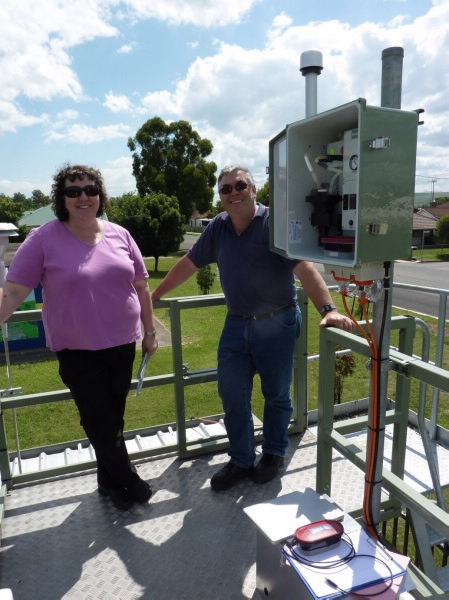 |
| Melinda Hale and David Garton at the Muswellbrook site in the upper Hunter with an ANSTO fine particle sampling unit. |
ANSTO scientists help to reveal the sources of fine particle air pollution in the Upper Hunter Valley.
A year-long study, commissioned by the NSW Health and theNSW Office of Environment and Heritage (OEH) and conducted jointly by scientists from ANSTO and CSIRO, has been undertaken to better understand the composition and sources of atmospheric particles in the Upper Hunter Valley.
The study aimed to identify the major components and sources of fine particles (i.e. particles less than 2.5 micrometres in diameter) in air around Singleton and Muswellbrook, the two main population centres in the Upper Hunter Valley.
Elevated levels of fine particles in winter have been of concern to the community for some time. The study showed that the largest source of winter-time fine particles is wood smoke from domestic wood heaters.
Professor David Cohen, Leader of the Centre for Accelerator Science, within ANSTO’s Institute for Environmental Research, points to a long-term record of data charting air pollution in the region since the 1990's.
Prof Cohen and his team used accelerator based ion beam analysis techniques, conducted on the Centre’s STAR accelerator, to provide quantitative analysis of airborne fine particles collected at Singleton and Muswellbrook.
This study concentrated on fine particle samples collected for 24 hours every three days during the whole of 2012. These samples were analysed by CSIRO and ANSTO to provide a comprehensive set of characterisation data. Using CSIRO chemical methods and ANSTO nuclear techniques it has been possible to identify the major pollution sources in the region.
Analysis of the chemical composition of the fine particles identified eight primary factors (listed below) in the air around Singleton and Muswellbrook. The study correlated this information with details such as the chemical fingerprints of the known sources, wind data and the pattern of seasonal variation in the factors.
“Some of the particles come with tell-tale markers that immediately identify the primary source while others are not emitted as particles but form by chemical reactions in the atmosphere and gas to particle conversions – these are termed secondary particles,” Dr Hibberd, of the NSW Health expert advisory committee on air pollution, said.
The primary factors in the Upper Hunter Valley air pollution were identified as:
- Wood smoke from domestic wood heaters. In winter wood smoke made up 63% of the fine particles in Muswellbrook and 38% in Singleton
- Secondary sulphate, or ammonium sulphate, formed in the atmosphere from natural sources of ammonium and sulphate from local and regional sources such as power stations
- Biomass smoke, that from prescribed burning and wildfires, distinguishable from smoke from domestic wood heaters by its chemical composition and periods of occurrence
- Industry aged sea salt - sea salt with the chlorine replaced by nitrate and sulphate from industrial emissions
- Soil - Note that results in this study cannot distinguish between soil dust from mining activities, agriculture or natural sources
The study found that at Muswellbrook the dominant factors in fine particle air pollution were wood smoke and secondary sulphate. At Singleton the dominant factors on an annual basis were secondary sulphate and industry aged sea salt.


